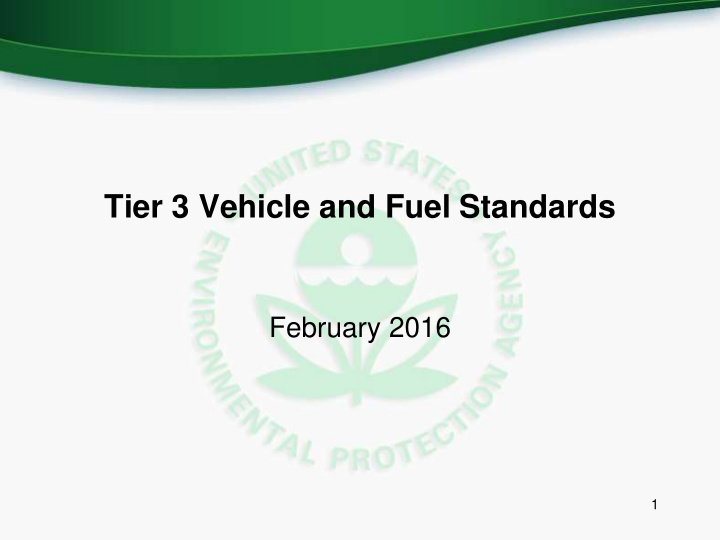



Tier 3 Vehicle and Fuel Standards February 2016 1
Overview • Overview of the Tier 3 Program – Tier 3 Vehicle Standards – Tier 3 Fuel Standards • Emissions and Air Quality Impacts • Compliance Schedules 2
Tier 3 Overview • Like Tier 2, a systems approach to reducing motor vehicle pollution: more stringent vehicle standards enabled by gasoline sulfur control • Similar structure to Tier 2, with standards that apply to all light-duty vehicles, light-duty trucks, and medium-duty passenger vehicles, as well as the fuel they use. • Vehicle standards that go beyond the stringency of the Tier 2 standards, but like Tier 2: – Create a harmonized vehicle program • Coordinated with California Low Emission Vehicle (LEV) III standards – Enable auto industry to produce and sell one vehicle nationwide • Lower sulfur gasoline beyond Tier 2 levels – Both Tier 3 and LEV III vehicle standards depend upon lower sulfur gasoline • Sulfur at current levels degrades the performance of vehicle catalytic converters, the primary emission control system on vehicles – Tier 3 vehicle standards not achievable without lower sulfur – Lower sulfur also provides immediate emission reductions from the existing fleet • Catalytic converters on existing cars will perform more effectively 3
Tier 3 Vehicle Standards • Phase in between 2017 and 2025 • Tighter VOC and NOx tailpipe standards – 80% reduction from today’s fleet average – Final fleet-average level of 30 mg/mile in MY 2025, compared with the current (Tier 2) level of 160 milligrams/mile (mg/mi) • Tighter PM tailpipe standard – 70% reduction in per-vehicle standard from Tier 2 • Evaporative emissions standards – Reduced fuel vapor emissions and improved system durability – Harmonized with LEVIII zero evaporative standards – most stringent levels ever required • Revised certification test fuel to be E10 – Better reflects in-use gasoline – Current certification test fuel has no ethanol 4
Tier 3 Fuel Standards • Fuels standards – Lower the annual average sulfur standard from 30 ppm under Tier 2 to 10 ppm • Starting January 1, 2017 – Maintain the current per-gallon sulfur caps • 80 ppm at refinery gate, 95 ppm at retail 5
Fuel Flexibilities • Annual average standard with a sufficiently high per-gallon cap • Flexible early credit program and nationwide averaging, banking and trading provide up to 6 years of lead time • Relief for small refiners and refineries <75,000 barrels per day – Three-year delay • Economic and technical hardship provisions available to all refiners • Additional flexibilities: – Carryover of “banked” credits from Tier 2 – Longer deficit carryforward in the case of a hardship 6
Emission Impacts Reductions in National On-Road Inventory 2018 2030 Reduction Reduction % Reduction % Reduction (US Tons) (US Tons) NOx 260,000 10% 330,000 25% VOC 48,000 3% 170,000 16% PM2.5 100 0.1% 8,000 16% Benzene 2,000 6% 5,000 26% • Lower NOx, VOC, and PM2.5 emissions lead to • Moderate to large ozone decreases across the country • Small to moderate PM decreases across the country 7
Air Quality and Public Health Impacts • Tier 3 standards will have immediate health and air quality benefits – Reduce ozone, particulate matter (PM), and toxics – Total Ozone and PM-related Premature Mortality Avoided: 770-2,000 in 2030 • Help States and local areas attain and maintain ozone and PM NAAQS – Tier 3 provides cost-effective national reductions that avoid more expensive local controls • Reduce pollution near roads – More than 50 million people live, work, or go to school near major roads • Total Monetized Benefits in 2030 (2011$):$6.7 to $19 Billion AQ Impacts in 2030 – Ozone AQ Impacts in 2030 – Annual PM 2.5 8
Compliance Schedules • Declining fleet average for FTP (NMOG+NOx) – 2017 starting point 86 milligrams/mile • Tier 2 current requirement is 160 milligrams/mile equivalent – 2025 end point at 30 milligrams/mile • Same level as LEV programs PZEVs – Yearly linear decline in fleet average requirement until 2025 – 5 year credit life and 3 year deficit – Average, banking and trading allowed • New PM standards phase-in schedule – 2017 through 2021 with 20%/20%/40%/70%/100% – Alternative phase-in option for earlier compliance • Test fuel and 150k useful life – Both are linked to vehicle specific bin level – New cleaner bins 70 and cleaner require new E10 and 150k – 2020 requires all certification bins use E10 and 150k useful life 9
APPENDIX 10
Summary of Costs and Benefits • Fuel Sulfur Standard – 0.65 cents per gallon • Vehicle Standards in 2025 – $72 per vehicle • Annual Cost in 2030 – Total Program: $1.5 billion • Vehicle Program: $0.76 billion • Fuel Program: $0.70 billion • Benefits outweigh costs by a factor of 4.5 to 13 11
Recommend
More recommend